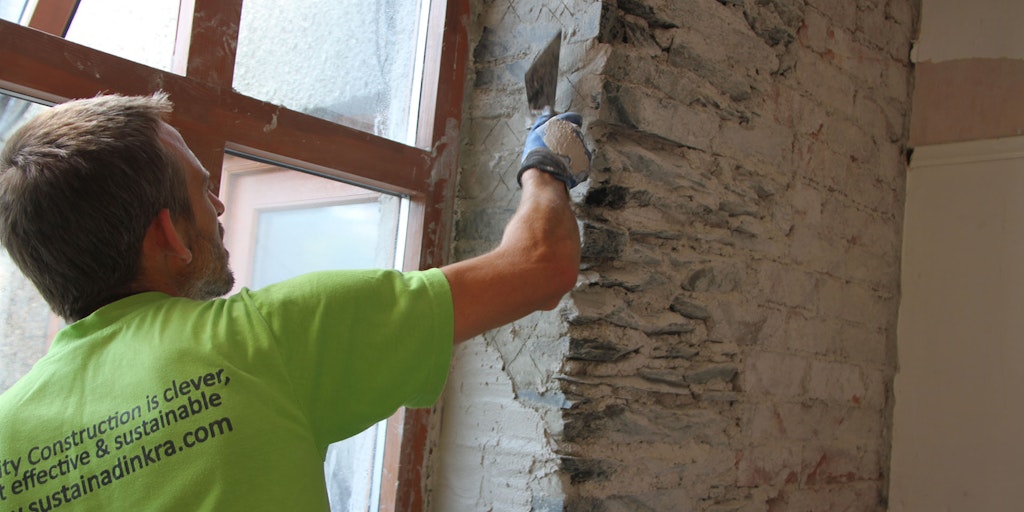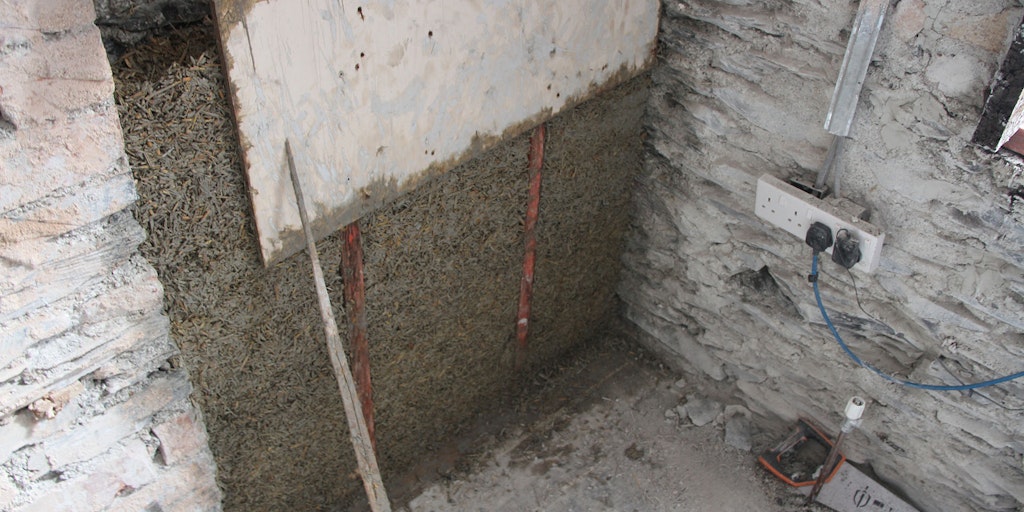
To address the climate crisis we need to rapidly reduce energy use, and refurbishing homes to high energy standards is one of the key measures that can help. CAT Information Officer Joel Rawson looks at some different approaches to transforming UK housing.

As highlighted in CAT’s Zero Carbon Britain reports, reducing our heating demand is key to a rapid decarbonisation. By allocating much less energy to heating, we’re able to make a much more realistic case for using a mix of renewable energy sources to meet energy needs across homes, transport and industry.
To achieve a high number of home retrofits very quickly, simple approaches that can be applied en masse are clearly important. However, retrofit shortcuts can lead to damaging and expensive failures – a carefully planned approach, considering the whole house, is vital. Older houses or those with more complex shapes will require more individual attention and specialist support.
As we’ll need to refurbish possibly a million houses every year for the next few decades, we urgently need a co-ordinated national programme. This will involve trained installers and advisors to ensure communities and individuals can get good advice, find specialists, and be confident of high-quality work. At the moment there are some projects dotted around the UK that we can look to for ideas and inspiration, and to evaluate different approaches.
Whole house retrofits
Taking individual measures without proper attention to detail and consideration of the ways different elements interact can make a house worse rather than improving it.
Upgraded glazing and draught-proofing can increase damp problems if there isn’t suitable ventilation. Leaving ‘cold bridges’ through a thick insulation layer will concentrate heat loss and may be prone to condensation.
The ‘whole house retrofit’ approach is intended to avoid these pitfalls. Instead of piecemeal efficiency measures, this systematic approach looks at all aspects of insulation, draught-proofing, ventilation and heating to create a structured plan. Such a retrofit is a big job, and you can treat it like a new build by engaging a specialist architect or retrofit expert to oversee the project and tailor the plan to your home. Houses in rows or blocks can be looked at together, as this should make accurate detailing easier as well as reducing costs.
Research has shown that spending more money and time on a deeper level of retrofit actually decreases the payback time when compared to measures added without consideration of how elements will interact.
The Government’s TrustMark scheme now covers professionals who carry out energy efficiency work including retrofits. It’s being linked to a new standard – ‘PAS 2035: Specification for the Energy Retrofit of Domestic Buildings’. The Association for Environment Conscious Building (AECB) focuses on environmentally-conscious materials, and their member listings can be filtered for ‘Carbonlite graduates’, from their own retrofit training. See also the pilot projects listed below.
Step by step
A full whole house retrofit may currently be out of reach for many, as we lack a nationwide commitment and supportive financial mechanisms. However, the risks from a piecemeal approach can be avoided by applying the same principle of careful planning to a more incremental approach. If you can’t do everything in one go, do still plan for the whole house – how one stage will lead to the next – and set priorities.
Take time first to understand the possible risks and how to avoid or monitor these. For example, don’t assume that a damp problem will be solved once you’ve insulated – investigate and address the issue first. Look carefully at how insulation, draughtproofing, ventilation and heating will all interact with each other and the building fabric. Check where issues such as cold bridging and thermal bypass could affect your plans.
Look into the use of tools such as a thermal imaging camera to see where heat is being lost and a door blower test to check airtightness, to give you better knowledge of what you’re starting with. This helps you to allocate your budget to where it will have most benefit, and to set improvement targets. It’s important to document and clearly communicate your targets to everyone you’re working with so that they know exactly what you want to achieve and how you’ll measure it.

Clear the air
If airtightness is not improved then increased insulation can fail to deliver the savings expected. It’s not just about doors and windows, but all edges and corners where materials join – such as where joists penetrate a wall, holes for pipes and cables, and so on.
People can be resistant to the concept of airtightness, associating it with being stuffy. But the key is that it works hand-in-hand with suitable ventilation. In a home with excellent airtightness you’re able to control ventilation properly, and people find that air quality actually improves.
In a well-sealed home, some sort of continuous ventilation is necessary to give fresh air while removing excess moisture and fumes from cooking, cleaning, washing and the like. You may not need a full heat recovery system unless you’re going for the highest level of retrofit. Ventilation could be more passive, but perhaps with targeted heat recovery fans in the bathroom and kitchen. Getting the choice and operation of ventilation right is crucial for a successful retrofit.
Keeping cool
Even with rapid action to decarbonise, warmer summers are predicted for the coming decades. Retrofitting to high levels of insulation and controlled ventilation will also help protect from overheating.
Your location and the orientation and size of your windows will determine the sort of shading that will complement other measures – so you benefit from the lower sun from autumn to spring, but avoid the high summer sun. Along with night-time ventilation, how much heat-absorbing ‘thermal mass’ your building has will be a factor, and the choice of internal or external insulation affects this.
Inside out
External insulation is often seen as preferable, as you have less disruption indoors and keep room sizes. Walls on the warm side of the insulation act as thermal mass, which is useful for retaining heat in winter as well as keeping cool in summer. External cladding is ideal for mass retrofit of whole rows or blocks. However, the detailing must be done well. This means dealing properly with all the external pipes and other gubbins so you don’t leave uninsulated cold bridges. A failed retrofit project in Preston mentioned in Clean Slate 113 had problems including roofs and guttering not extending over the external insulation. Water got behind the insulation, causing horrible damp problems. Extending the roof to cover the cladding is recommended – this could be combined with the installation of solar panels to share scaffolding costs.
However, older houses in conservation areas may have restrictions on changing their appearance, or there may be no space in an area with narrow streets. In some houses you’ll find a combination may work – for example, internal insulation at the front to maintain the façade and external insulation across a mainly blank side wall.

Internal insulation may be preferable for old stone houses, where external cladding could actually result in too much thermal mass. It can be practical as part of a more spread out retrofit, with the house upgraded in stages.
Because thick internal insulation makes the walls colder, this can lead to the risk of interstitial condensation (condensation inside the walls). This may cause various problems, depending on the structure. It’s possible to make a technical case under building regulations to justify a layer slightly below standards that minimises this risk. It may also be worthwhile to put in some monitoring to keep track of damp levels.
You should cut away the perimeter of any intermediate floors to allow for continuous internal insulation. Otherwise you’ll get air leaks and heat loss (thermal bypass) between floors. This involves careful attention to joists running through the insulation layer into the cold wall. For a good airtight finish you’ll want to fix internal insulation boards over a continuous plaster coat, rather than a ‘dot and dab’ method (which is prone to thermal bypass).
For both internal and external insulation, detailing at windows and doors is important to stop them being thermal bridges, vulnerable to damp and mould. If the shape of window leaves very little space for insulation, then a small amount of a very thin higher-specification material could be appropriate. For example a composite of plasterboard with high-performance aerogel insulation.

Natural choices
To avoid creating or exacerbating damp problems, breathable natural fibre insulation materials are ideal for solid wall insulation. Options include rigid wood-fibre boards and composites of lime and hemp, cork or other plant fibres. At CAT, we promote these materials for other reasons too.
By using materials with a low embodied energy in manufacturing (compared to plastic foam, for example) we narrow the gap between our energy demand and the amount we’re generating from renewable energy, and can phase out fossil fuels more quickly. An additional benefit is that carbon absorbed from the atmosphere as plant fibres grew will be sequestered within a building for many decades.
Judith Thornton, CAT guest lecturer and Clean Slate contributor, has been keeping a blog about her retrofit of an old stone house. She’s been adding a mix of lime and miscanthus grass (to see how this does in place of hemp), plus corkboard in the window reveals and a cork-lime plaster in the fireplace. Take a look at our Free Information Service webpages for a link, and for more on these and other natural and low-impact materials.
Examples and resources
Finances can be a barrier, with a big upfront cost needed to unlock future savings. In some areas zero (or very low) interest loans are available, and there are a few local projects giving householders support on working out a retrofit approach that will reduce their carbon footprint and energy bills.
There are a number of trial retrofit programmes that have Government funding to evaluate different approaches. In general, the aim of these projects is to raise the knowledge of householders and building professionals, to link the two groups together and to ensure effective and good quality refurbishments:
- People Powered Retrofit (Greater Manchester) – Carbon Co-op/URBED
- Futureproof (parts of the west of England) – Centre for Sustainable Energy
- Ecofurb (London) – Parity Projects
- Warmer Sussex – Retrofit Works
- Cosy Homes Oxfordshire – Low Carbon Hub
- Homeworks (Cornwall) – BRE
The Mayor of London has also recently launched a ‘Retrofit Accelerator’ programme for the capital’s boroughs and housing associations. Another project is ‘Energiesprong’, which uses an industrialised model to minimise costs. Buildings are measured and bespoke insulating panels for walls and roof are manufactured offsite. They’re concentrating on houses with simple shapes, in blocks or terraces, generally through housing associations and local authorities.
Find out more
For more advice and links on retrofit options see CAT’s information service webpages.
About the author
Joel Rawson is CAT’s Information Officer, providing free and impartial advice on a wide range of topics related to sustainability. He first came to CAT to volunteer in 2001, and graduated with a CAT postgraduate diploma in 2013.
- Climate Change
- Building
- News Feed
Related Topics
Enews Sign Up
Stay up-to-date with the latest news, events and activities from CAT by signing up to our Enews and following us on social media.



